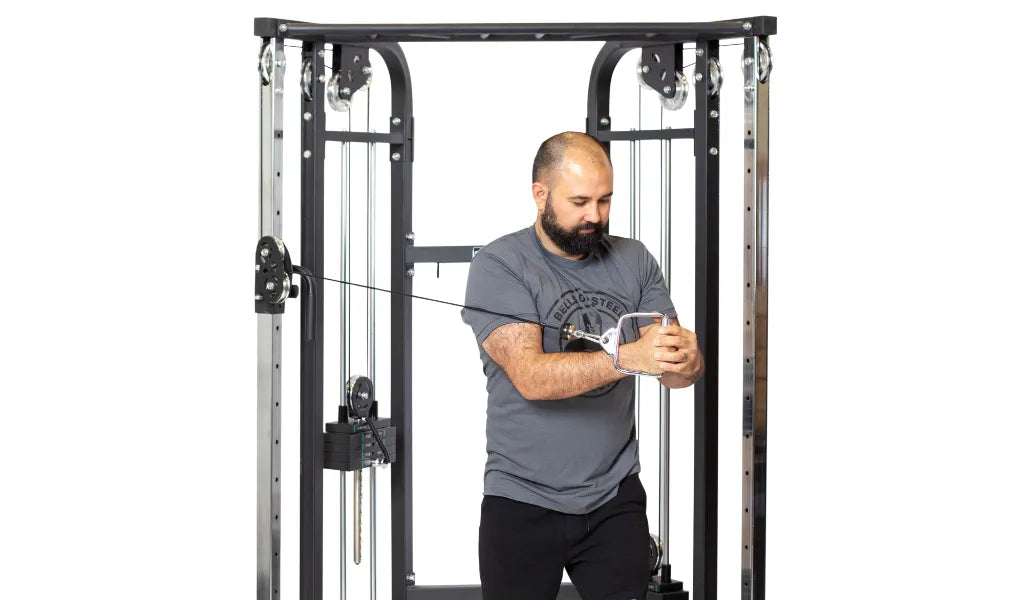Cable machines are a staple in many gyms, including home setups. They offer versatility, ease of use, and a broad range of motion for various exercises. But as much as we love these nifty contraptions, they’re not without their drawbacks.
Let’s delve into the potential disadvantages of cable machines, while also highlighting why they’re still a fantastic addition to most home gyms. Grab your protein shake and let’s get started!
Who Might Find Cable Machines Less Than Ideal?
Budget-Conscious Gym Enthusiasts
If you’re pinching pennies, a cable machine might not be your first choice. Quality cable machines can be pricey, and for home gym owners on a budget, this might be a significant drawback. Shopping around, considering different options, and looking for a good balance between value and quality can help offset the sticker shock.
Space-Savers
Cable machines are the heavyweights of the gym equipment world—not because they’re loaded with plates, but because they take up a lot of space. If your home gym is more of a gym nook, fitting a cable machine might feel like playing an intense game of Tetris.
However, cable towers are compact options that unlock the basics and innovative designs like the All in One Trainer tuck neatly into a corner for those with less space than an airplane seat in their home gym.
Limitations of Cable Machines
Lack of Functional Training
While cable machines offer a controlled and guided range of motion, they can fall short in functional training. Free weights and bodyweight exercises often engage stabilizer muscles and mimic real-world movements more effectively. If your goal is to improve functional strength, relying solely on cable machines might not cut it.
Potential for Limited Resistance
For the Arnold Schwarzeneggers out there, cable machines might not provide enough resistance to challenge those Herculean muscles. Some machines have weight limits that advanced lifters might quickly surpass, making them less suitable for heavy-duty strength training. You want to deadlift 400lbs, you’re gonna need a barbell and some weight plates.
Dependency on Maintenance
Cable machines come with moving parts—pulleys, cables, and weight stacks—that require regular maintenance. Over time, cables can fray, and pulleys can wear out. If you’re not handy with repairs or don’t want to shell out for maintenance, this could be a hassle.
On the other hand, it’s all part of the home gym experience. Take care of your stuff and it will last longer. *Side eyes car that’s overdue for an oil change.*
The Bright Side: Why Cable Machines Still Rock
Despite their drawbacks, cable machines bring a lot to the table. Let’s flex some positive vibes and see why they’re still worth considering.
Versatility and Variety
Cable machines are like the Swiss Army knife of gym equipment. From chest flies and tricep pushdowns to lat pulldowns and bicep curls, the exercise possibilities are nearly endless. This versatility helps keep workouts fresh and engaging, making it easier to stay motivated.
Safety First
For those who are new to lifting or working out solo, cable machines offer a safer alternative to free weights. The guided motion reduces the risk of injury from improper form or dropping weights. It’s like having a built-in spotter without needing to bribe your buddy with post-workout shakes.
Constant Tension
One of the standout benefits of cable machines is the constant tension they provide throughout the entire range of motion. This can lead to improved muscle activation and growth. It’s like giving your muscles a never-ending pump party.
Easy Adjustments
Switching exercises and adjusting weights on a cable machine is a breeze. No more fumbling with weight plates or setting up different equipment. With a few quick adjustments, you can seamlessly transition from one exercise to another, keeping your heart rate up and your workout flow smooth.
FAQs About Cable Machines
Q: Can I build muscle with cable machines alone?
A: Absolutely! While free weights are great, cable machines can also help you build muscle effectively, thanks to the constant tension and versatile range of exercises.
Q: How often should I maintain my cable machine?
A: Regular maintenance checks every 3-6 months can help keep your cable machine in top shape. Keep an eye out for frayed cables and worn pulleys.
Q: Are cable machines good for beginners?
A: Yes! Cable machines are excellent for beginners due to their guided range of motion and reduced injury risk. They help newcomers learn proper form and build confidence.
Conclusion: The Balanced Perspective
While cable machines do come with some disadvantages, such as cost, space requirements, and maintenance needs, they also offer significant benefits that can enhance your home gym experience.
Their versatility, safety, and constant tension make them a valuable addition for many fitness enthusiasts. So, weigh the pros and cons, and decide if a cable machine is the right fit for your fitness goals and home gym setup.



